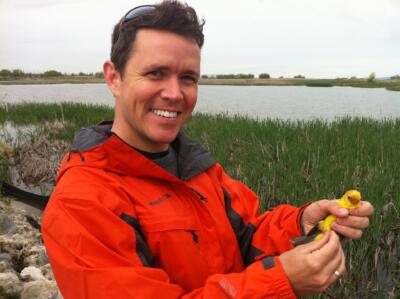Study shows how organic growers and wild birds can benefit one another
Written by Heather Estrada, OFRF Research & Education Senior Scientist
Organic producers rely on natural biological controls as a key component of their Integrated Pest Management (IPM) strategies against crop pests. Because wild insectivorous birds play a substantial role in biocontrol of many pests, organic producers often maintain natural areas or install perennial habitat plantings such as hedgerows and field borders to encourage diverse wild bird populations. However, in addition to some birds directly damaging crops, food safety and animal health concerns have been raised because wild birds can carry pathogenic bacteria, viruses, or parasites that affect humans and livestock.

Dr. Jeb Owen, holding a Tanager.
In 2015, a group of researchers from Dr. Jeb Owen’s lab at Washington State University received a USDA NIFA Organic Agriculture Research and Extension Initiative (OREI) research grant to investigate the costs and benefits of encouraging wild bird populations on organic farms. The goals of the Avian Biodiversity: Impacts, Risks and Descriptive Survey (A-BIRDS) project were threefold: 1) to identify the relationship between wild bird biodiversity and farm-level management practices, 2) to determine the role of insectivorous wild birds in controlling insect pests, and 3) to assess the risk presented by wild birds in spreading pathogens that endanger human and livestock health.
Researchers conducted in-depth surveys of species diversity, prey consumption, and the occurrence of fecal pathogens in wild bird populations over a three-year period on 52 organic farms in CA, OR, and WA. Highly diversified and organic vegetable-only and vegetable-livestock integrated farms with a range of field sizes, proportions of natural areas, and overall diversity of the agroecosystem landscape, were included in the survey.
Results suggest that more natural habitat in the farm landscape increased the density of native bird species and reduced the density of non-native species, which have the potential to be invasive. Farms with livestock consistently supported greater bird density and diversity, which was most pronounced in farms with the least amount of natural area. The increased bird density and diversity on crop-livestock farms may be attributed to a combination of common factors: smaller farm size, greater landscape diversity, and more integration of woody crops compared to crop-only farms.
The next phase of this project involved the collection and DNA analysis of 1,200 bird fecal samples from participating farms. Results showed that wild birds consumed 30 orders of insects, including 103 insect species that are known to be crop pests, confirming that birds can perform important agroecosystem services through the biological control of insect pests. Finally, some 3,200 samples of bird feces were tested for Campylobacter spp., Salmonella spp., and Escherichia coli (E. coli) bacteria. Bird feces commonly (10% of samples) carried Campylobacter, and rarely carried Salmonella or Shiga toxin-forming pathogenic E. coli (STEC). Campylobacter increased with livestock density but decreased with the extent of natural areas on the farm, which highlights the potential for natural habitat to reduce crop contamination by birds.
Overall, these findings indicate that maintaining natural areas and a patchwork landscape with small fields bordered by natural areas can enhance wild bird populations and potential predation on insect pests without contributing to food safety risks. This research has been published widely in academic journals and shared to farmer audiences through numerous extension talks.


